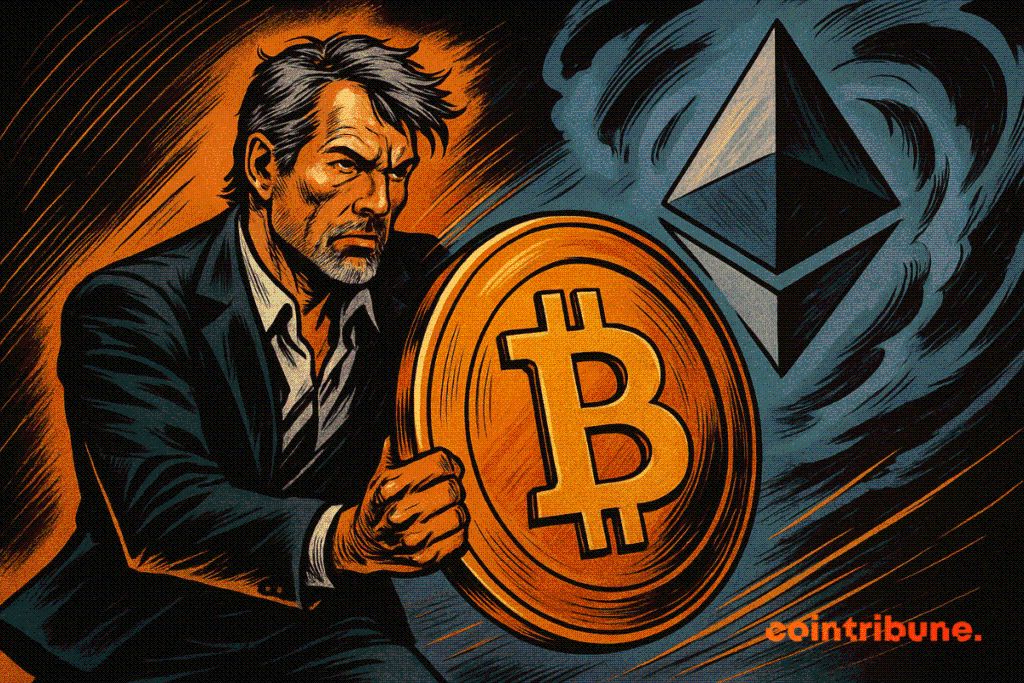Michael Saylor Stands Firm on Bitcoin Amid Ethereum’s Growing Popularity
Altcoins are no longer a fleeting bubble. Their presence is consolidating to the point of attracting the biggest names in traditional finance. BlackRock, a Wall Street giant, is now opening up to leading cryptos like ether. This institutional shift changes the game in the crypto ecosystem. However, for Michael Saylor, a leading figure of MicroStrategy, a hierarchy is imposed: bitcoin remains the benchmark. And even if Ethereum shines, he refuses to grant it the same status.

In Brief
- Bitcoin holds 60.18% market share, far ahead of institutional altcoin competition.
- MicroStrategy owns 628,791 BTC, worth approximately $74.15 billion.
- Financial products backed by bitcoin attract cautious investors, with returns from 8.5% to 11.5%.
- Physical gold prices reinforce Saylor’s argument in favor of digital gold.
Bitcoin holds its rank despite the altcoins wave
Michael Saylor does not see the rise of altcoins as a direct threat to bitcoin’s supremacy.
I think there is an explosion of innovation across the entire crypto economy, and on the margin it is good for everybody in the digital asset space
In fact, bitcoin maintains its dominance: 60.18% market share according to TradingView. MicroStrategy holds 628,791 BTC (about $74.15 billion), far ahead of MARA Holdings and its 50,639 BTC.
Saylor remains unwavering : “I’m laser-like focused on Bitcoin.” According to him, it is the clearest global monetary asset, combining low risk and high return. Meanwhile, Ethereum rises 23% in 30 days, reaching $4,224, driven by institutional demand and ETFs. But Saylor does not budge: for him, the heart of digital treasury remains bitcoin.
Michael Saylor, the digital capital engineer
Beyond accumulating bitcoin, Saylor designs financial products to integrate it into the most cautious portfolios.
His innovations:
- Strike stock: BTC exposure + guaranteed dividend;
- Strife: senior BTC bond, 8.5% yield;
- Strike high yield: 11.5%;
- Stretch CRC: equivalent to Treasury bonds, 9% monthly yield.
Result: massive enthusiasm, with $600M raised during the fourth preferred stock offering. Retail, institutional investors, and hedge funds each find their place.
Macro signals strengthening bitcoin
Economic policies also feed into Saylor’s argument. Latest example: American taxation on physical gold.
This measure, he says, accelerates the migration of capital towards an asset without logistical constraints or customs barriers.
Saylor anticipates a wave of capital flowing from traditional stock and credit markets toward bitcoin-backed instruments. He sees a crypto market where digital gradually absorbs the value of the physical.
Figures and landmarks:
- 628,791 BTC in MicroStrategy’s treasury;
- 160 public companies holding BTC;
- $11.77B: corporate Ethereum market;
- +23%: ether growth in 30 days.
For him, altcoin innovation stimulates the ecosystem but does not change bitcoin’s trajectory as the digital monetary standard.
Michael Saylor is not just building a reserve: he is orchestrating a bold long-term plan , calibrated to capture trillions. Every bitcoin added to his arsenal is a piece of a global puzzle. His goal: to erect a financial architecture where bitcoin will be the foundation, capable of withstanding cycles and absorbing the value of traditional markets.
Disclaimer: The content of this article solely reflects the author's opinion and does not represent the platform in any capacity. This article is not intended to serve as a reference for making investment decisions.
You may also like
Crypto, TradFi sentiment improves: Will Bitcoin traders clear shorts above $93K?

Bitcoin catches a bid, but data shows pro traders skeptical of rally above $92K

Trending news
MoreBitget Daily Digest (Dec. 9)|Michael Saylor is promoting a Bitcoin-backed banking system to governments; the CFTC has launched a digital asset pilot program allowing BTC, ETH, and USDC to be used as collateral
[English Thread] Wake-up Call and Review for the Crypto Industry in 2025: Where Is the Direction of the Next Cycle?
